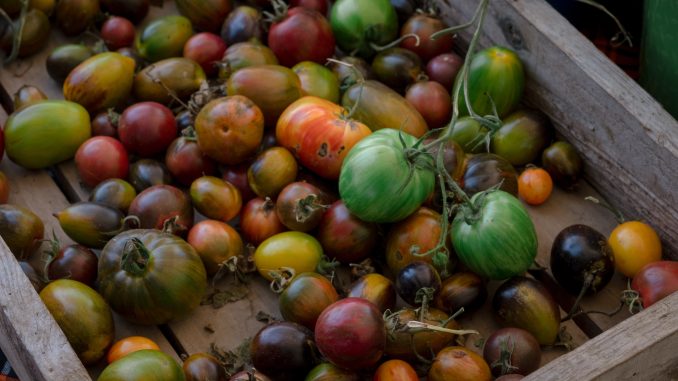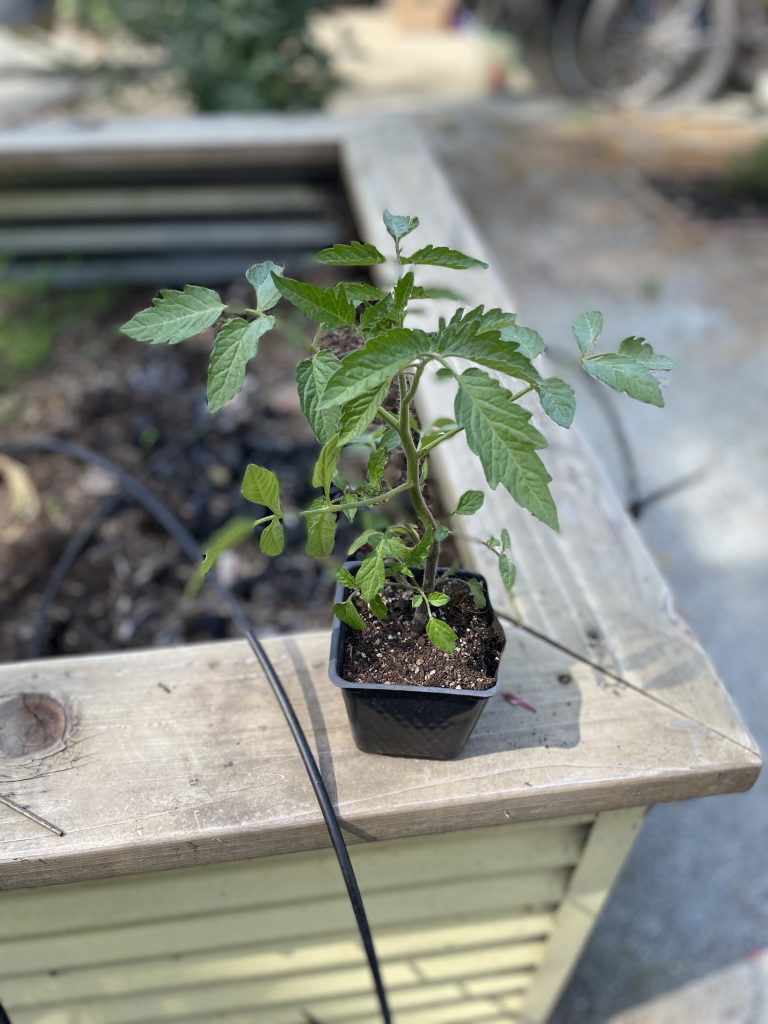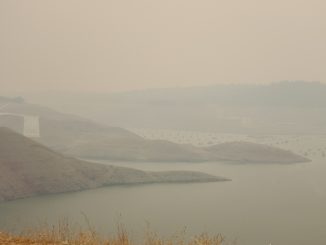
It’s May, and the initial tomato frenzy has died down. The nurseries have sold the bulk of their tomato starts, and most are likely in the ground, already showing several blossoms. Your tomato plants no doubt have plenty of space and support and are already sending their roots deep into the well-fertilized soil of your garden. But on the horizon, a killer awaits.
Before long, the forecast will reveal weeks-long waves of temperatures of 100 and higher (in 2022, between June 9 and Sept. 9, Chico cracked the century mark 38 times). The world is getting hotter, and as it does the tomato plant’s sun-loving nature is taking a beating.
It’s no secret that tomatoes do well in most of California, but for backyard gardeners in our neck of the state, in addition to the usual fights versus pests and disease, summers bring the battle to protect this beloved crop from extreme heat.
To help Nor-Cal gardeners improve their tomato game, the CN&R brings you some informed advice from two experts: Debbie Arrington, a lifelong gardener and an award-winning garden writer for the News & Review; and Sherri Scott, farmer and owner of Harvests & Habitats Nursery.
Tips for keeping your tomato plants happy
Any Californian with a few square feet of outdoor space grows tomatoes (or wants to) with dreams of hefty slicers by the Fourth of July. There’s a reason our tomato mania is so strong: Tomatoes thrive here.
Our area has plenty of what tomato plants crave: sun and heat. But how much is too much?
Prolonged triple-digit heat waves can toast tomatoes.
When temperatures stay above 90 degrees for several days, tomato flowers may drop off or refuse to set fruit. Leaves can fry and turn crispy. Ripening tomatoes may split or develop calluses.

So give your vines a hand—along with enough water and shade—to cope with extreme heat. This advice comes from UC Cooperative Extension master gardeners, as well as longtime local tomato growers.
Water early and deep. Each tomato plant needs at least five gallons a week. Irrigate your tomatoes in the morning, making sure water reaches down at least 6 inches into the soil. How do you know? Test the soil with a probe or long screwdriver; it should easily plunge into the soil. Or use a trowel, dig down (away from the roots) and look.
During hot weather, water tomatoes two to three times a week. Tomatoes normally wilt during a hot afternoon; that’s OK. But if they’re wilted in the morning, water immediately. Some tomato varieties will wilt every day during summer heat regardless of how much water they receive. This tends to happen with Russian heirlooms such as Black Krim.
Tomatoes planted in containers may need extra water every day during hot weather. Their potting soil tends to dry out faster. Plants in black containers are particularly susceptible to heat-related problems.
Keep watering consistent and don’t let soil dry out completely. That can lead to blossom end rot—the hard brown callus on the flower end of a tomato. Inconsistent watering also can cause fruit to split.
Mulch is your tomato plant’s friend. Make sure your vines have at least 2 to 4 inches around them to help keep roots cool and soil evenly moist. Straw, leaves or shredded bark make the best tomato mulch. Many gardeners prefer straw (not hay) because its light color reflects intense sun rays instead of absorbing heat. Hay contains seeds that can sprout and suck nutrients out of soil.
Don’t fertilize during a heat wave. It just puts more stress on the plant. When you do feed them, stay away from high-nitrogen fertilizers; they’ll produce luxurious vines but no tomatoes.
If foliage turns brown, leave the dead leaves in place. They help protect the fruit from sunburn. After the heat has subsided, prune off the completely dead leaves so new foliage can grow.
With these tips, your tomatoes can flourish all summer long. They’ll be happier plants, and you’ll be a happier gardener, too.
Tomato Q&A with Harvests & Habitats Nursery owner Sherri Scott
By Jason Cassidy
Is it too hot for tomatoes in Butte County?
A lot of people are asking why they can’t grow tomatoes any more, and I would say that a lot of the farms are not struggling like backyard gardeners are.
We are learning that tomatoes can’t set fruit in the heat; they’ll drop their flowers—the pollen becomes sterile and then they’ll drop. We’re not cooling down like we used to. Out at the farms they do get the breezes. A lot of the farms are out near the riparian corridors where they get some extra cool down. In town, we have the urban heat sink. With more asphalt and more houses, it’s not cooling down anymore.
If extreme heat is forecast, what can you do to protect plants?
They do need the sun to set flowers, and they do need the sun to ripen. If you really want to control your environment, then [you can] shade when it gets really hot and your flowers are in pollination. Once they set fruit, it probably would be fine to remove [the shade].
When people say shade, a lot of folks automatically assume shade cloth. If you’re going to do that, they have different gradations, and I was reading that 30 percent [will] still let in enough light and cool it down a bit.
[Shade on plants] is not my first choice for cooling it down. I think there are others—shading the area, shading the house. Find a place [to plant] that’s further away from a structure or cement or things that hold heat; find ways to cool down the property without eliminating the sun.

Any suggestions for cultivars that do well in our area?
Varieties can make a difference. Definitely the bigger the tomato, the harder it is for it to set fruit. Some of the really old heirlooms—like the potato-leaf type—have this kind of flower that doesn’t allow for as good of self-pollination.
[Plant] smaller varieties: Cherries are pretty steady. Find heat-tolerant varieties. I’m shopping for seeds that have some heat-tolerance bred into them—Homestead, Floridade, Arkansas Traveler, those are a few.
Other suggestions for what to look for when choosing plants?
The other thing that I really love is determinates. With indeterminates, the harvest is over a long season and [the plants] get huge. They just keep on going. Determinates have a shorter lifespan, they tend to be really early, they tend to come all at once. So, there’s a lot more control. You’re sure to get a harvest.
I’m suggesting to folks who’ve been having trouble to try some determinates. You aren’t tortured with caring for this plant over the long season. Even Romas are a determinate.
Another thing to think about is where your seeds are coming from. For instance, Redwood Seeds, they grow their own seeds. They’re local, they’re in Tehama County where it’s hot as heck in the summers, too. If they’re getting tomatoes for seed, they’re getting harvest. Locally adapted seeds is something I’m pushing for—getting seeds from a seed company that has a like climate.
Also, I’ve been really wanting as a community to come together and share seeds. If we have a neighbor who’s successfully growing a non-hybrid variety, if they could save seeds and share it … we can together create a locally adapted variety.
A few tomato plant care tips:
Worms?
Finding ways of making your yard more inviting to birds is good. Also, hand picking [the worms], and having [the plant pruned and] more open so you can see them.
What kind of mulch?
I like rice straw because it’s a little bit more malleable; it forms a mat so it’s really good at suppressing weeds. Having that straw not only helps keep the moisture, but it also really encourages the microfauna and microflora. It protects them and gives them moisture and there’s this interaction.
Morning or afternoon sun?
I’ve seen too many people try to grow tomatoes in morning sun. I think just the cherries might make it. The bigger ones definitely need as much sun as possible. It’s not just growing the fruit, but it’s also the flavors. The flavors are really going to come from that heat and more sun.
And if all else has failed?
I would recommend that people plant a cherry tomato and a determinate tomato, or other small fruited one, then get one of the big slicers from the farmers.




Be the first to comment